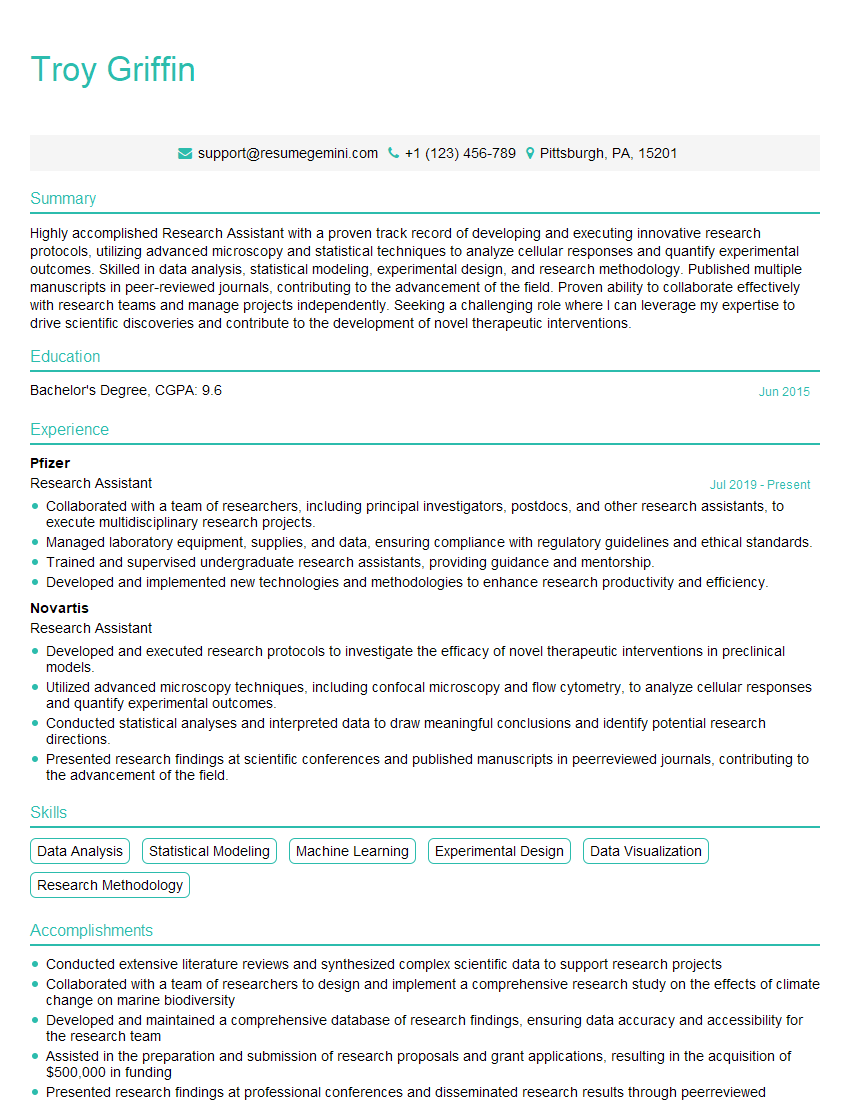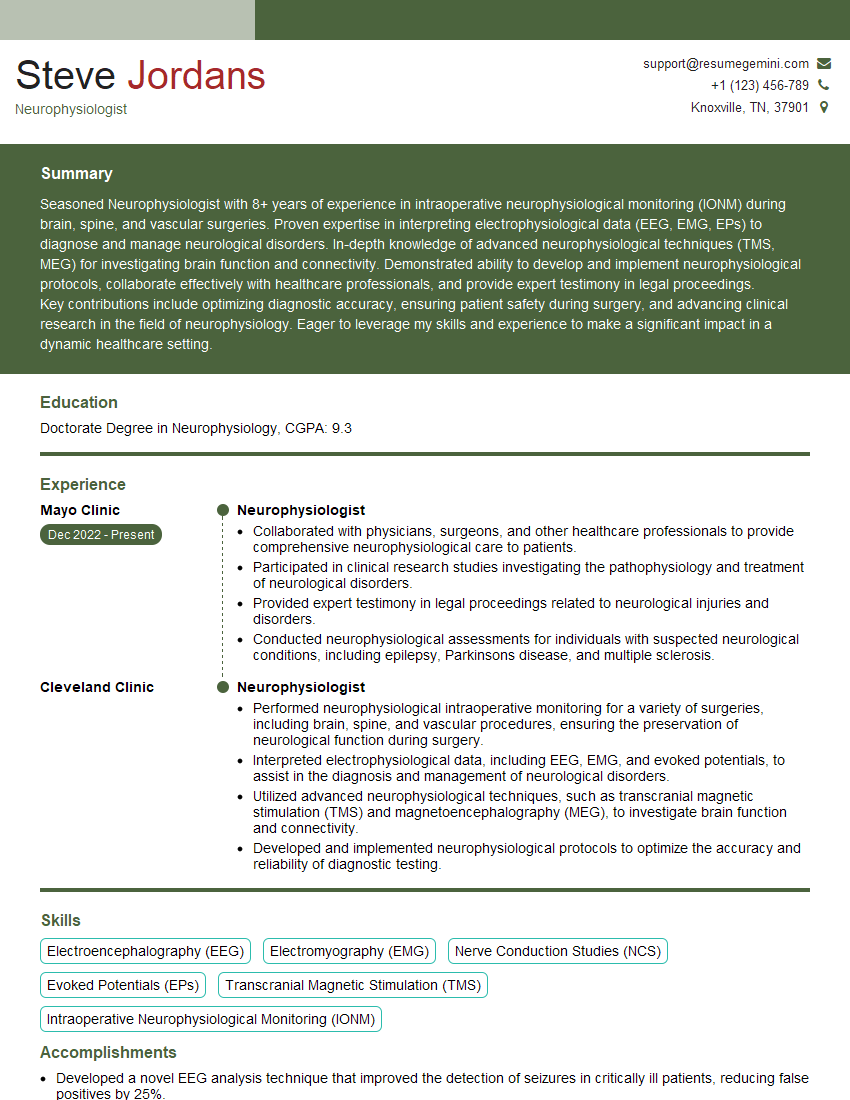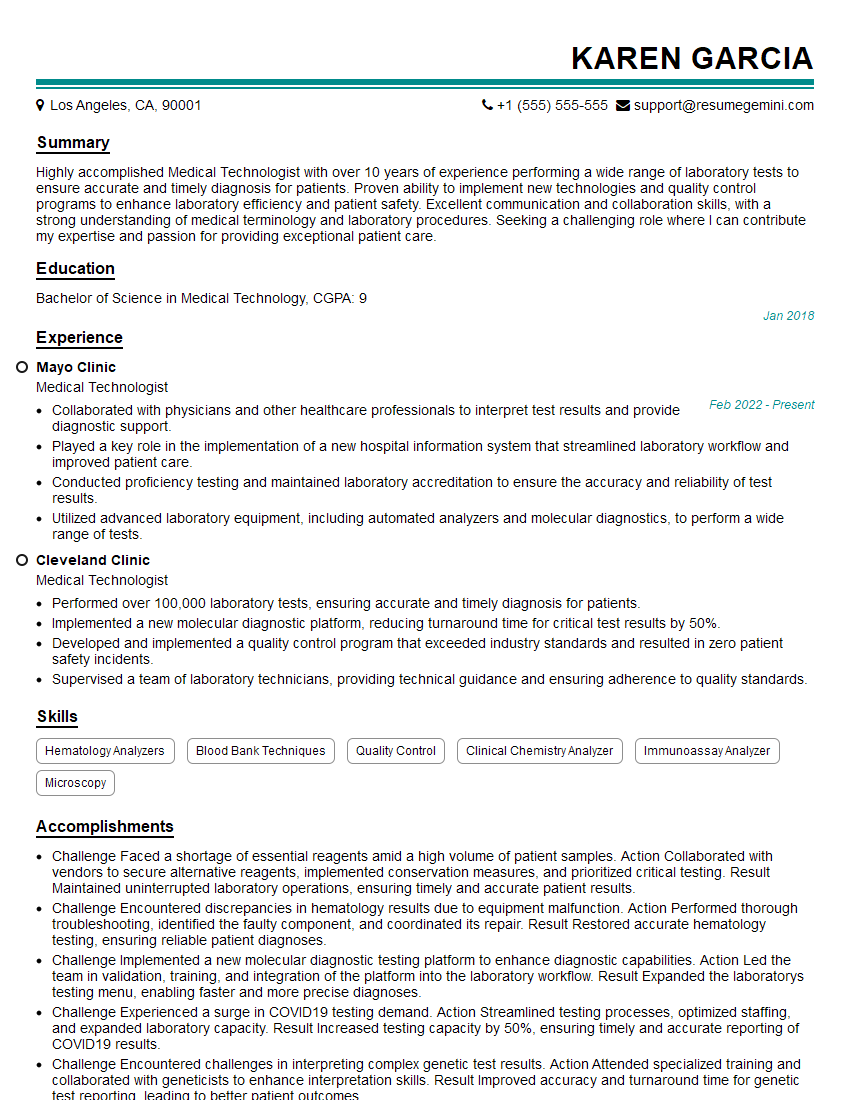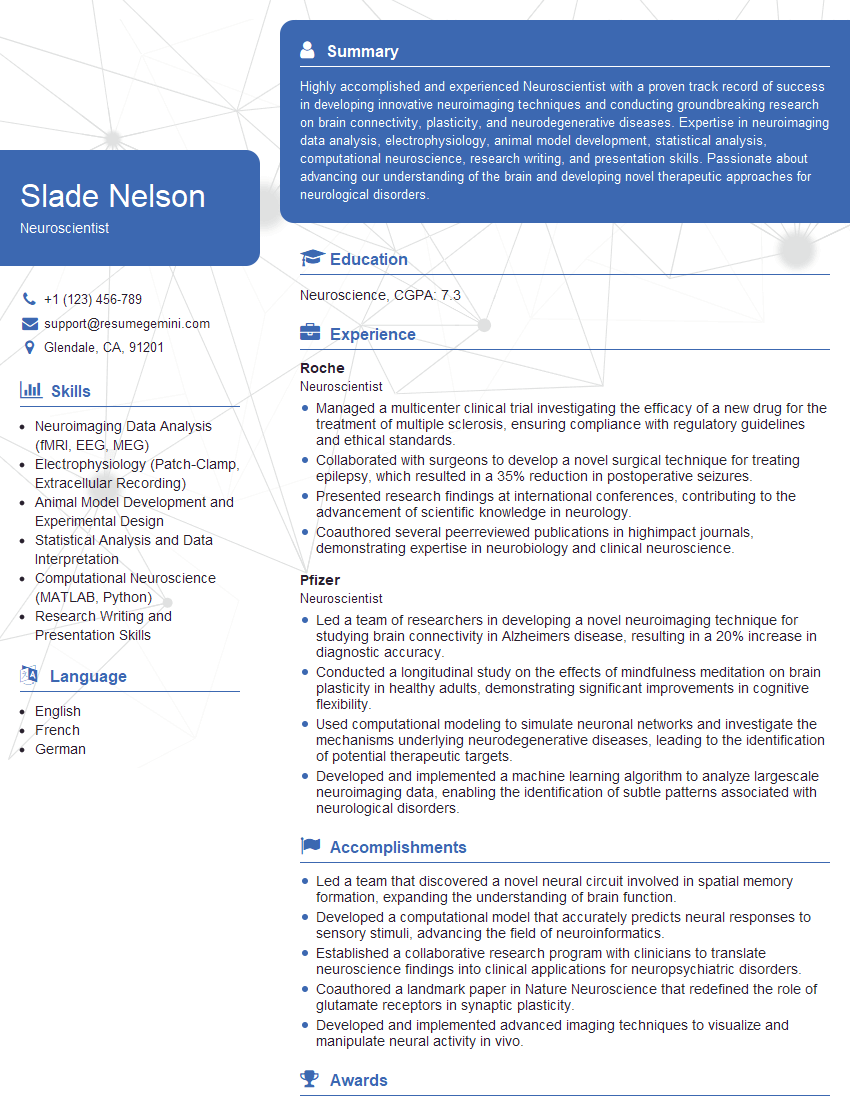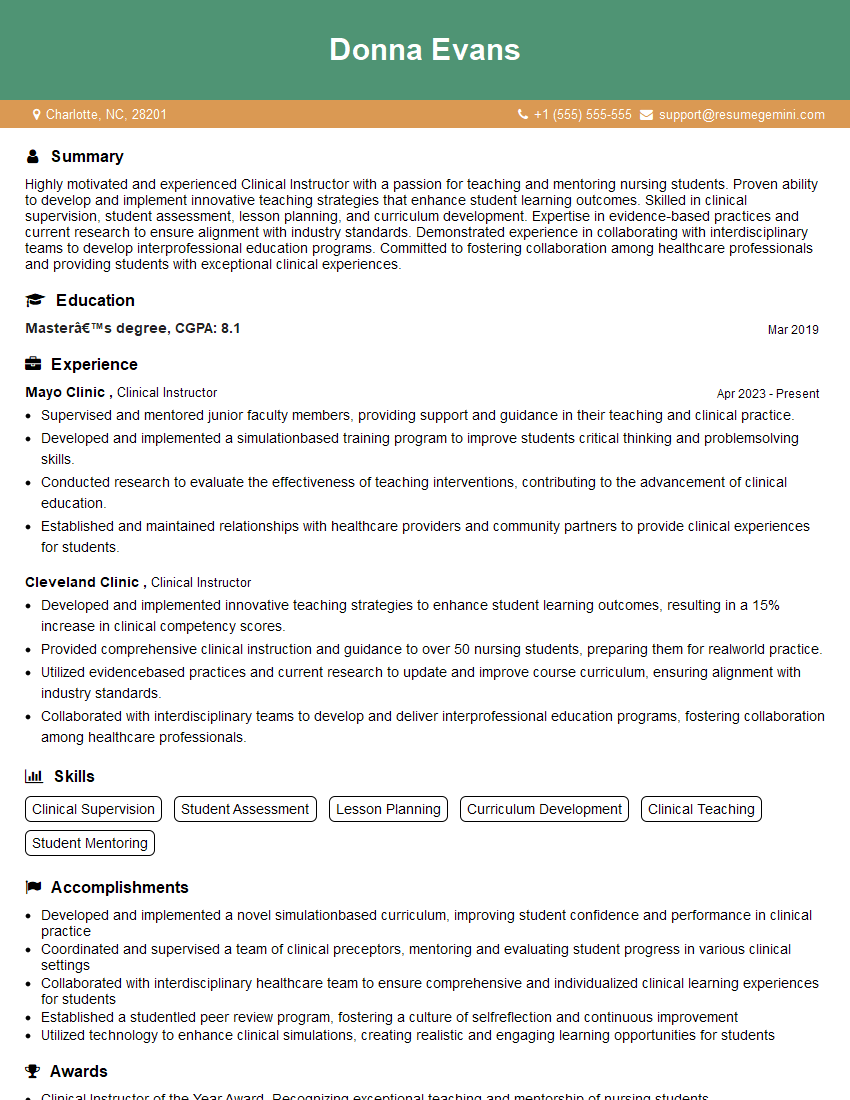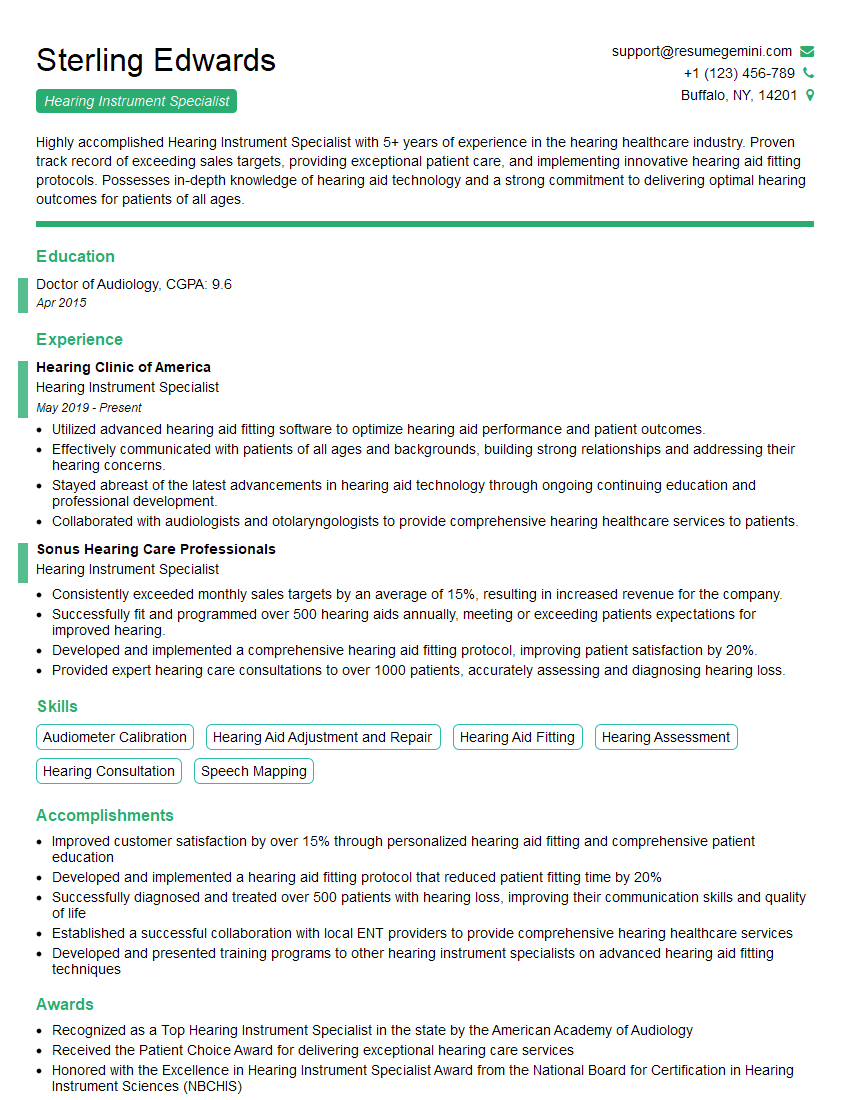Cracking a skill-specific interview, like one for Auditory Brainstem Response, requires understanding the nuances of the role. In this blog, we present the questions you’re most likely to encounter, along with insights into how to answer them effectively. Let’s ensure you’re ready to make a strong impression.
Questions Asked in Auditory Brainstem Response Interview
Q 1. What are the different waveforms observed in an ABR recording?
The Auditory Brainstem Response (ABR) recording shows a series of five to seven positive and negative peaks, usually labeled I through VII. These peaks represent the electrical activity generated in different parts of the auditory brainstem in response to sound. Think of it like a relay race: each peak signifies a baton handoff from one brainstem structure to the next.
- Wave I: Originates in the auditory nerve (specifically, the distal portion of the eighth cranial nerve).
- Wave II: Represents activity in the cochlear nucleus.
- Wave III: Thought to be generated primarily in the superior olivary complex.
- Wave IV: A complex wave, often representing a combination of activity from the superior olivary complex and the lateral lemniscus.
- Wave V: Generally attributed to the inferior colliculus, a crucial midbrain structure.
- Waves VI and VII: Less consistently identified and may reflect activity from various brainstem structures, including the lateral lemniscus and inferior colliculus.
The amplitude (height) and latency (time delay) of each wave are carefully measured and analyzed. Variations from normal values can indicate auditory pathway dysfunction.
Q 2. Explain the physiological basis of the ABR.
The ABR reflects the synchronous electrical activity of the auditory nerve and brainstem structures in response to auditory stimuli. When a sound is presented, the auditory nerve fibers fire, generating electrical potentials. These potentials are summed, amplified, and transmitted along the auditory pathway (cochlear nucleus, superior olivary complex, lateral lemniscus, inferior colliculus). Each structure’s response contributes to the characteristic peaks observed in the ABR waveform. Imagine it as a domino effect – each falling domino (brain structure) triggers the next, creating a measurable electrical signal.
The precise timing and amplitude of each wave are dependent on the integrity of the neural pathways and the synchronicity of neural firing. Any damage or dysfunction along the pathway can alter the shape, amplitude, and latency of the ABR waves, making it a valuable diagnostic tool.
Q 3. Describe the different types of ABR stimuli used.
Several types of stimuli are used to elicit ABRs, with click stimuli being the most common. However, different stimulus types can provide unique information.
- Click Stimuli: These are brief, transient sounds that activate a broad range of frequencies in the cochlea. They’re easy to use and are effective in assessing the overall auditory pathway.
- Tone Bursts: These are sounds of a specific frequency, allowing for frequency-specific assessment of hearing. This helps pinpoint the location of a hearing loss (e.g., high-frequency hearing loss).
- Chirps: These stimuli present a rapidly changing frequency, offering improved temporal resolution and less susceptibility to certain artifacts compared to click stimuli.
The choice of stimulus depends on the clinical question and the suspected location of any pathology. For instance, tone bursts are useful when a specific frequency range needs evaluation.
Q 4. What are the common clinical applications of ABR?
ABR testing has a wide range of clinical applications, primarily in the assessment of auditory function, particularly in situations where traditional hearing tests are difficult or impossible to obtain.
- Neonatal Hearing Screening: Identifying hearing loss in newborns is crucial for early intervention. ABR is a valuable tool for objective hearing assessment in infants who cannot cooperate with traditional behavioral tests.
- Auditory Neuropathy Spectrum Disorder (ANSD) Diagnosis: ABR can help differentiate ANSD from other forms of hearing loss as it may show abnormal responses even with normal outer hair cell function.
- Brainstem Lesion Detection: ABR abnormalities can indicate the presence of tumors, multiple sclerosis, or other neurological disorders affecting the brainstem auditory pathways.
- Intraoperative Monitoring: ABR is utilized during surgery near the brainstem to monitor the integrity of auditory pathways in real-time.
- Assessment of Hearing Loss in Patients with Cochlear Implants: ABR can help determine the effectiveness of cochlear implants and identify potential issues with the implant’s functionality.
Q 5. How do you interpret an ABR result?
Interpreting an ABR result involves assessing several key parameters, including the presence, latency, and amplitude of the waves. Each wave’s latency is compared to normative data for age and stimulus type. A delay in wave latency suggests slowed neural conduction, often indicative of damage along the auditory pathway.
For example, a prolonged Wave I latency might point to a problem in the auditory nerve, while delayed Wave V latency could indicate damage in the midbrain. Reduced amplitude can also be significant, suggesting fewer active neural fibers.
The overall pattern of abnormalities provides valuable insights into the nature and location of the auditory dysfunction. A detailed report includes absolute latencies, interpeak latencies (the difference in latency between waves), and amplitude measurements, all interpreted in the context of the patient’s medical history and clinical findings.
Q 6. What are the limitations of ABR testing?
While ABR is a valuable tool, it does have limitations.
- Limited Frequency Specificity (with click stimuli): Click stimuli activate a broad frequency range, making it difficult to pinpoint the exact frequency of hearing loss.
- Susceptibility to Artifacts: Muscle activity (e.g., eye blinks, body movements), electrical interference, and electrode placement can introduce artifacts into the recording, making interpretation challenging.
- Inability to Assess Higher Auditory Centers: ABR primarily assesses the brainstem, providing limited information about the function of higher auditory centers in the cortex.
- Difficult Interpretation in Some Cases: Interpretation can be complex in cases with significant hearing loss or severe neurological conditions.
It’s crucial to consider these limitations and utilize ABR in conjunction with other diagnostic tests for a comprehensive assessment.
Q 7. How do you troubleshoot common ABR artifacts?
Troubleshooting ABR artifacts involves careful attention to detail at every stage of the testing process.
- Proper Electrode Placement: Ensuring correct electrode placement is critical. Poor placement can result in decreased signal amplitude or distorted waveforms.
- Grounding and Shielding: Adequate grounding and shielding minimize electrical interference from external sources.
- Patient Movement and Muscle Activity: Instructions to the patient, proper patient positioning, and possibly sedation for very young or uncooperative patients minimize artifacts from muscle activity.
- Artifact Rejection Techniques: Sophisticated software incorporates artifact rejection algorithms that automatically identify and eliminate noisy data segments from the recordings.
- Re-testing: If artifacts significantly compromise the recording quality, the test should be repeated.
A systematic approach to troubleshooting ensures high-quality recordings and reliable interpretations. Remember, a clean ABR recording is paramount for accurate diagnostic conclusions.
Q 8. Explain the difference between absolute and interpeak latencies.
Auditory Brainstem Response (ABR) testing uses electroencephalography (EEG) to measure the brain’s response to auditory stimuli. Both absolute and interpeak latencies are crucial measurements derived from these responses, but they represent different aspects of neural timing.
Absolute latency refers to the time elapsed between the presentation of the auditory stimulus and the arrival of a specific wave peak (e.g., wave I, III, V) at the recording electrode. Think of it like measuring the total travel time of a runner in a race – from the starting gun to the finish line. It reflects the overall conduction time along the auditory pathway up to that specific wave’s generator.
Interpeak latency, on the other hand, represents the time difference between two successive wave peaks. For example, the latency between wave I and wave III (I-III interpeak latency) or between wave III and wave V (III-V interpeak latency). This is analogous to measuring the time difference between two runners reaching a particular checkpoint. It reflects the time it takes for the neural signal to traverse a specific portion of the auditory pathway between those wave generators. Interpeak latencies are often more clinically useful than absolute latencies because they are less susceptible to variations in electrode placement and overall stimulus timing.
Q 9. Describe the procedure for performing an ABR test.
Performing an ABR test involves several steps:
- Patient Preparation: The patient lies supine and remains still. For infants, sedation may be necessary. Electrode impedance is checked to ensure good signal quality (ideally below 5 kΩ).
- Electrode Placement: Small electrodes are placed on the scalp, usually at the vertex (Cz), and behind each ear (typically A1 and A2 for the ipsilateral and contralateral ears). A ground electrode is also placed.
- Stimulus Presentation: Click stimuli or tone bursts are delivered through earphones or inserts at various intensities, typically starting at high intensities and decreasing in steps. The click stimuli are usually 80-100 dB nHL while tone bursts are typically 40-70dB nHL. The stimuli are presented to one ear at a time.
- Signal Acquisition: The EEG signals are amplified and averaged over hundreds or thousands of stimulus presentations. Averaging helps to eliminate background noise and enhance the weak ABR waves.
- Wave Identification and Measurement: A trained audiologist or technician identifies the characteristic ABR waves (I, III, V, sometimes even VII) on the resulting waveform. They measure the absolute and interpeak latencies and amplitudes of these waves.
- Interpretation and Report Generation: The measured latencies and amplitudes are compared to normative data to determine if the ABR is normal or abnormal, indicating potential neurological issues.
Q 10. What factors can affect ABR results?
Several factors can significantly impact ABR results. These include:
- Patient Age: ABR latencies naturally increase with age.
- Temperature: Hypothermia can prolong latencies, while hyperthermia can shorten them.
- Sedation: Sedatives can affect the ABR waveforms and may mask abnormalities.
- Electrode Impedance: High impedance can result in poor signal quality and unreliable measurements.
- Stimulus Parameters: The type, intensity, and rate of the stimulus can influence the ABR response.
- Hearing Status: Significant conductive or sensorineural hearing loss can affect the amplitude and latency of ABR waves.
- Neurological Conditions: Conditions affecting the brainstem, such as tumors or demyelinating diseases, can alter the morphology and latency of the ABR waves.
- Head Position: Maintaining a consistent head position is critical for accurate measurements.
It’s crucial to carefully consider these factors during testing and interpretation to avoid misdiagnosis.
Q 11. How do you determine the appropriate stimulation parameters for an ABR test?
Choosing appropriate stimulation parameters is crucial for obtaining reliable ABR results. The key parameters include:
- Stimulus Type: Clicks are the most common, providing a broad frequency representation, while tone bursts offer more frequency-specific information. The choice depends on the clinical question.
- Stimulus Intensity: This should be adjusted based on the patient’s estimated hearing threshold. Starting at a high intensity (e.g., 70-80 dB nHL for clicks) and progressively reducing it helps to assess the response across different intensity levels. Usually, the intensity that provides a clear response is chosen.
- Stimulus Rate: Typically ranging from 10 to 20 stimuli per second, it affects the signal-to-noise ratio. Slower rates generally result in better waveform definition.
- Polarity: Both rarefaction (compression) and condensation clicks can be used. Rarefaction clicks are typically preferred because they offer a better signal-to-noise ratio.
The selection of these parameters is often guided by the clinical question and the patient’s individual characteristics.
Q 12. What are the normal values for ABR latencies and amplitudes?
Normal ABR latencies and amplitudes vary with age and stimulus parameters (e.g. Click vs Tone Burst). There aren’t universally fixed numbers, but rather age-related norms. A detailed normative database is generally consulted for interpretation, these are often provided by the ABR equipment manufacturer. Generally:
Latencies: Absolute latencies for wave V typically fall within a range based on age, while interpeak latencies (I-III, III-V) also follow age-specific norms. For example, in adults, Wave V latency is typically below 6 milliseconds. The exact range is highly dependent on the type of stimulus and the normative data used.
Amplitudes: Wave amplitudes vary considerably, and their absolute values are less crucial than their presence and relative proportions. A significant reduction in amplitude may suggest hearing loss or neurological issues.
It’s crucial to rely on age-appropriate normative data for accurate interpretation. This is not something to be calculated or approximated; clinical interpretation relies heavily on published norms for the specific ABR system used.
Q 13. How do you differentiate between normal and abnormal ABR findings?
Differentiating between normal and abnormal ABR findings requires a comprehensive assessment. Key indicators include:
- Waveform Morphology: Absence of characteristic waves (especially Waves I, III, V), presence of unusual waves, or altered wave shapes can indicate pathology.
- Latencies: Prolonged absolute or interpeak latencies beyond the established normative values for the patient’s age suggest delayed neural conduction, often indicative of neurological problems.
- Amplitudes: Markedly reduced amplitudes may suggest hearing loss or other neural involvement.
- Inter-Wave Relationships: Abnormal relationships between the latencies of different waves can point to specific sites of neurological damage along the auditory pathway.
A complete interpretation takes into account the entire ABR waveform and its deviation from expected norms. In cases of ambiguity, additional testing or specialist consultation may be necessary.
Q 14. What is the role of impedance in ABR testing?
Impedance plays a crucial role in ABR testing, as it represents the resistance to the flow of electrical current through the electrodes and skin. High impedance can significantly degrade the quality of the recorded signal by introducing noise and attenuating the ABR waves, thus influencing their amplitudes and making it difficult to identify the individual waves. This can lead to inaccurate latency measurements or a false interpretation of an absent or abnormal response.
Before performing the test, it is essential to ensure that electrode impedance is within an acceptable range (typically below 5 kΩ). This is achieved through proper electrode preparation, such as cleaning the skin and using conductive gel. If impedance is too high, it is important to repeat the electrode application until the acceptable range is achieved. Electrodes should be checked periodically throughout the test to ensure consistent impedance and signal quality.
Q 15. How do you manage patient discomfort during ABR testing?
Patient comfort is paramount during ABR testing, especially with infants and young children. We employ several strategies to minimize discomfort. First, we create a calm and reassuring environment. Soft lighting, soothing sounds, and a gentle, friendly approach from the testing personnel can significantly reduce anxiety. For infants, we often conduct the test while they are sleeping or feeding, ensuring minimal disturbance. We explain the procedure to parents or guardians beforehand, answering any questions they might have to ease their concerns and promote cooperation. We also use the smallest electrodes possible and apply them with a hypoallergenic adhesive to minimize skin irritation. In situations where sedation is deemed necessary and appropriate by a medical professional, this may also be employed, but it’s crucial to carefully weigh the benefits against potential risks. The entire process is carefully monitored and we stop immediately if any signs of distress are observed.
Career Expert Tips:
- Ace those interviews! Prepare effectively by reviewing the Top 50 Most Common Interview Questions on ResumeGemini.
- Navigate your job search with confidence! Explore a wide range of Career Tips on ResumeGemini. Learn about common challenges and recommendations to overcome them.
- Craft the perfect resume! Master the Art of Resume Writing with ResumeGemini’s guide. Showcase your unique qualifications and achievements effectively.
- Don’t miss out on holiday savings! Build your dream resume with ResumeGemini’s ATS optimized templates.
Q 16. What are the potential risks associated with ABR testing?
ABR testing is generally considered safe. However, potential risks are minimal but include discomfort from electrode placement (which is temporary), infection at the electrode sites (though rare with proper hygiene), and rarely, allergic reactions to the electrode adhesive. The electrical stimuli used are very low in intensity and pose no danger to the patient. It’s important to note that ABR is a non-invasive procedure. The primary risks are associated with the rare complications of electrode application or allergies. We address these by employing careful skin preparation, using hypoallergenic adhesives, and by being vigilant for any signs of infection or allergic reaction during and after the test. Pre-test discussions with patients and/or guardians address and mitigate any concerns.
Q 17. Explain the difference between ABR and other electrophysiological tests (e.g., ASSR).
While both ABR and Auditory Steady-State Response (ASSR) are electrophysiological tests used to assess hearing, they differ significantly in their methodologies and applications. ABR measures the brainstem’s response to brief acoustic clicks or tone bursts, revealing neural activity along the auditory pathway within the first few milliseconds. It’s primarily used to identify the presence or absence of hearing, and to roughly estimate hearing thresholds. In contrast, ASSR uses continuous, rapidly alternating tone signals to elicit a steady-state response from the auditory cortex. It can assess hearing thresholds across a broader range of frequencies, including some of the frequencies where ABR is less sensitive, offering more detailed information about the auditory system’s responsiveness. ABR is better for identifying neural synchrony along the auditory nerve whereas ASSR is better at assessing the integrity of the auditory cortex and is often used with patients who aren’t ideal candidates for ABR (e.g., those with significant neurological conditions). Think of ABR as a quick check for a general hearing problem, whereas ASSR provides a more detailed frequency-specific analysis.
Q 18. Describe the use of ABR in newborn hearing screening.
ABR is a cornerstone of newborn hearing screening. Its effectiveness stems from its ability to detect hearing loss even in sleeping infants, minimizing the need for cooperation from the baby. The procedure is quick, painless, and objectively measures the auditory pathway’s response. Early detection of hearing loss through ABR is critical because early intervention dramatically improves language development and overall quality of life. The test typically involves presenting clicks or tone pips to the baby’s ears and monitoring the electrical responses using electrodes placed on the scalp. A wave pattern on the recording indicates healthy hearing. Absence of specific waves, or abnormalities in the pattern, may signal a hearing impairment. Results are quickly obtained, allowing for swift referrals to further audiological evaluation and intervention if needed. This helps ensure that children with hearing loss receive the appropriate treatment as soon as possible, ideally within the first few months of life.
Q 19. How do you interpret ABR results in the context of other diagnostic information?
ABR results are not interpreted in isolation. They are carefully considered alongside other diagnostic information, such as the results of behavioral tests (if the child is old enough to cooperate), otoscopic examination (to assess the outer ear), tympanometry (to evaluate middle ear function), and medical history. For example, a normal ABR might be interpreted differently if the child has a history of meningitis or other neurological conditions. Similarly, an abnormal ABR might suggest hearing loss, but the severity and type of hearing loss needs to be determined by combining ABR results with other assessment methods. A comprehensive understanding requires correlating ABR data with clinical findings and behavioral responses. The collaborative efforts of audiologists, pediatricians, and other specialists are often crucial in formulating a proper diagnosis and management plan.
Q 20. What are the different types of hearing loss that can be identified using ABR?
ABR can help identify various types of hearing loss, primarily differentiating between conductive, sensorineural, and mixed hearing loss. Conductive hearing loss, caused by problems in the outer or middle ear (e.g., ear infections, otosclerosis), will often show delayed or absent responses only if the conductive issue is severe enough to significantly reduce sound transmission to the inner ear. Sensorineural hearing loss, resulting from damage to the inner ear or auditory nerve (e.g., genetic factors, noise exposure, aging), often presents with absent or abnormal waves. Mixed hearing loss, which combines conductive and sensorineural components, shows a combination of these characteristics. However, ABR cannot always precisely pinpoint the location or exact type of hearing loss. Further tests are usually required for more detailed information regarding the site and extent of the hearing loss. ABR offers valuable insights but forms part of a wider diagnostic process.
Q 21. What are the current challenges and future directions in ABR technology?
Current challenges in ABR technology include improving the accuracy and reliability of the test, particularly in identifying mild hearing loss or specific types of hearing impairment. Researchers are actively exploring advanced signal processing techniques and novel electrode designs to enhance the sensitivity and specificity of ABR. Future directions involve incorporating artificial intelligence and machine learning algorithms for more automated interpretation of ABR waveforms, reducing reliance on manual scoring and improving diagnostic consistency. This would also help in quicker and efficient processing of the large number of ABR tests that are performed. Another area of interest is the development of portable and user-friendly ABR systems suitable for widespread use in various settings, including remote clinics and developing countries. This would improve accessibility and early intervention, particularly for newborn hearing screenings in areas with limited resources. Ultimately, the goal is to achieve faster, more accurate, and more accessible ABR testing to better serve patients and improve their hearing health.
Q 22. Describe your experience with ABR data acquisition and analysis software.
My experience with ABR data acquisition and analysis software spans over a decade, encompassing a wide range of systems. I’m proficient in using both commercially available software packages like NeuroScan and Bio-Logic, and I also have experience with open-source options and customized analysis tools. My expertise extends beyond basic data acquisition to include advanced signal processing techniques, artifact rejection, and automated report generation. For instance, I’m skilled in utilizing different filtering techniques to optimize signal-to-noise ratios in challenging recordings, and I regularly use automated peak identification algorithms, followed by manual verification to ensure accuracy. I understand the nuances of different stimulus types and their impact on the data analysis, including click, tone burst, and chirp stimuli. I’m also comfortable adjusting parameters such as sweep speed, number of sweeps, and filter settings to optimize for different patient populations, such as infants or individuals with hearing loss.
Q 23. How do you ensure the quality and reliability of ABR results?
Ensuring the quality and reliability of ABR results is paramount. This involves a multi-faceted approach beginning with meticulous attention to detail during data acquisition. This includes careful electrode placement to minimize artifact, ensuring a proper impedance level, and using appropriate stimulus parameters based on the patient’s age and clinical presentation. Following data acquisition, I rigorously assess the waveforms for artifacts, such as muscle activity or electrical noise. I employ both automated and manual artifact rejection techniques, and I may repeat recordings if necessary to achieve high-quality waveforms. Beyond artifact rejection, I assess the reproducibility of the responses by comparing multiple averages. Finally, I always consider the clinical context alongside the ABR findings for a comprehensive interpretation.
For example, if I observe inconsistent latencies or amplitudes across multiple recordings, I investigate possible reasons like poor electrode contact or patient movement. I meticulously document these observations and steps taken to address them in the final report. The quality of the ABR data is crucial for accurate diagnosis and treatment planning.
Q 24. Explain your understanding of the legal and ethical considerations of ABR testing.
Legal and ethical considerations in ABR testing are crucial. Patient confidentiality is paramount; all patient information is handled according to HIPAA regulations and similar local guidelines. Informed consent is essential. Patients or their guardians must understand the procedure, its purpose, benefits, and potential risks before testing. This includes explaining the purpose of the test and how the results will be used. Accurate and unbiased reporting of results is vital. The ABR report should be clear, concise, and avoid subjective interpretations. It’s essential to maintain objectivity and avoid bias in both data acquisition and interpretation. Finally, appropriate documentation and record-keeping procedures are important for both legal and professional reasons.
In situations involving minors, parental or legal guardian consent is mandatory, with careful explanation adjusted to their level of understanding. All my actions are guided by professional ethical standards and relevant legal regulations in my practice.
Q 25. Describe a challenging ABR case you encountered and how you approached it.
One challenging case involved a premature infant with suspected auditory neuropathy spectrum disorder (ANSD). The infant was extremely fragile, making it difficult to obtain high-quality recordings. We faced challenges with maintaining electrode contact due to movement and obtaining sufficient sweeps for reliable averaging. My approach was to employ a combination of strategies. First, we used specialized electrodes designed for infants, optimizing electrode placement to minimize movement artifact. Second, we adjusted the acquisition parameters to increase the number of sweeps and reduce the sweep speed. We also used advanced artifact rejection techniques to clean the data. Third, we collaborated closely with the neonatology team to optimize the testing environment to minimize external noise and ensure the infant’s comfort and safety. After meticulous data acquisition and analysis, we were able to obtain interpretable ABR results that were consistent with the clinical suspicion of ANSD. This case highlighted the importance of adapting techniques to individual patient needs and emphasizing collaboration with other healthcare professionals.
Q 26. How do you communicate ABR results to healthcare providers and patients?
Communicating ABR results requires clear, concise, and empathetic communication tailored to the audience. When communicating with healthcare providers, I provide a comprehensive report including details of the testing procedure, raw data, quantitative measures (latencies, amplitudes), and a clear interpretation of the findings in relation to the clinical question. I use professional terminology where appropriate but explain complex concepts in readily understandable terms, often supported by visual aids like waveform tracings. For patients and their families, communication is adjusted to their level of understanding. I avoid technical jargon and explain the results in plain language, using analogies and visuals to clarify the meaning of the findings. I focus on explaining what the results imply about their hearing and answer their questions thoroughly, offering emotional support as needed. It is crucial to ensure that the patient understands the implications of the findings and the next steps in their care.
Q 27. What are your strengths and weaknesses as they relate to ABR testing?
My strengths lie in my thoroughness, attention to detail, and proficiency in advanced signal processing techniques. I’m adept at troubleshooting technical issues and interpreting complex waveforms. I consistently strive for the highest quality data and accurate interpretations, prioritizing patient care. One area for continued development is expanding my experience with newer ABR technologies, particularly those incorporating machine learning for automated analysis. While I’m proficient in current methods, actively exploring and integrating cutting-edge techniques will further enhance my skills and efficiency. I am committed to continuous learning and professional development to address this.
Q 28. How do you stay current with the latest advancements in ABR technology?
Staying current with advancements in ABR technology is an ongoing process. I regularly attend professional conferences and workshops, participate in continuing medical education (CME) activities focused on auditory electrophysiology, and actively follow peer-reviewed literature in relevant journals such as the Journal of the American Academy of Audiology and Ear and Hearing. I actively engage with online communities and professional organizations dedicated to audiology and electrophysiology, participating in discussions and sharing knowledge with colleagues. I also regularly review the updates and new features released by manufacturers of ABR equipment and software to ensure my skills remain up-to-date with the latest technological developments.
Key Topics to Learn for Auditory Brainstem Response Interview
- Wave V Latency and Amplitude: Understand the significance of Wave V latency and amplitude measurements in diagnosing auditory pathway dysfunction. Explore the factors influencing these measurements and their clinical interpretation.
- Interpreting ABR Results: Practice analyzing ABR waveforms to identify normal and abnormal findings. Learn to differentiate between various types of hearing loss based on ABR patterns. Develop your skills in explaining complex results clearly and concisely.
- Stimulus Parameters and Artifact Reduction: Master the knowledge of different stimulus types (click, tone burst) and their applications. Understand techniques for minimizing artifacts and optimizing recording quality for accurate interpretation.
- ABR in Different Populations: Explore the applications of ABR in various populations, including newborns, infants, and adults with neurological conditions. Understand how to adapt testing procedures based on individual needs.
- Technical Aspects of ABR Testing: Gain a solid understanding of the equipment used in ABR testing, including electrodes placement and impedance checks. Be prepared to discuss troubleshooting common technical issues.
- Correlation with Other Diagnostic Tests: Understand how ABR results relate to other audiological tests (e.g., OAE, Tympanometry) and how to integrate findings for a comprehensive diagnosis.
- Ethical Considerations and Patient Communication: Develop your skills in explaining complex medical information to patients and their families in a clear and compassionate manner. Be prepared to discuss ethical considerations in ABR testing.
Next Steps
Mastering Auditory Brainstem Response (ABR) testing opens doors to exciting career opportunities in audiology and related fields. A strong understanding of ABR principles and applications is highly sought after by employers. To maximize your job prospects, creating an ATS-friendly resume is crucial. ResumeGemini is a trusted resource to help you build a professional and impactful resume that showcases your ABR expertise. Examples of resumes tailored to Auditory Brainstem Response are available to help guide you through this process. Invest time in crafting a compelling resume – it’s your first impression on potential employers!
Explore more articles
Users Rating of Our Blogs
Share Your Experience
We value your feedback! Please rate our content and share your thoughts (optional).
What Readers Say About Our Blog
This was kind of a unique content I found around the specialized skills. Very helpful questions and good detailed answers.
Very Helpful blog, thank you Interviewgemini team.






